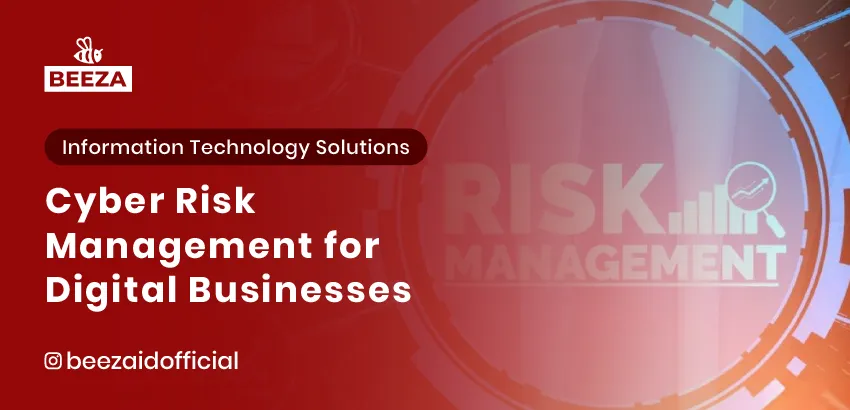
Introduction: Cyber Risk Management for Digital Businesses
In today’s fast-paced digital world, businesses rely heavily on technology for daily operations. While digitalization offers speed and convenience, it also brings serious threats in the form of cyber risks. From data breaches to ransomware attacks, cybersecurity threats can cause significant financial losses and long-term reputational damage.
Cyber risk management has become a crucial part of maintaining a secure, reliable, and resilient business environment. In this article, we’ll explore what cyber risks are, why they matter, and how businesses can strategically manage and mitigate them in 2025 and beyond.
What Are Cyber Risks?
Cyber risks are potential threats or vulnerabilities in digital systems that can cause disruption, loss, or unauthorized access to sensitive information. These risks can originate externally (like hackers) or internally (like employee errors). Common cyber risks include:
- Data breaches and identity theft
- Service disruptions from DDoS attacks
- Ransomware attacks demanding payment for system recovery
- Insider threats from employees or vendors
All businesses connected to the internet are exposed to cyber threats, regardless of their size or industry.
Why Cyber Risk Management Is Critical for Businesses
- Protecting Customer Data and Brand Reputation
Trust is essential in business. A single data breach can destroy customer confidence and damage brand integrity. - Avoiding Financial Loss
The cost of recovering from a cyber attack can run into millions. This includes incident response, downtime, legal fees, and fines. - Regulatory Compliance
Industries like finance, healthcare, and e-commerce are subject to strict data protection regulations such as GDPR or local cybersecurity laws. - Ensuring Business Continuity
Cyber incidents can halt operations, leading to productivity losses and missed opportunities.
Steps for Effective Cyber Risk Management
1. Identify Critical Assets and Risks
✅ Map out critical systems, databases, and digital touchpoints
✅ Recognize vulnerable entry points and sensitive data
✅ Analyze potential threats based on business model and industry
💡 Example: A digital banking platform must protect mobile apps, user credentials, and payment systems.
2. Conduct Risk Assessment
- Evaluate the likelihood and impact of different threats
- Prioritize risks based on severity and exposure
- Use frameworks like NIST, ISO 27005, or FAIR for structured assessments
💡 Tip: Involve multiple departments in this process to ensure all risks are considered.
3. Develop Risk Mitigation Strategies
🔐 Implement multi-layered security solutions
🔄 Perform regular data backups stored in secure locations
👨💻 Enable multi-factor authentication (MFA) and role-based access control
💡 Modern approach: Use biometric authentication and eKYC to enhance digital identity verification.
4. Educate Employees and Build Cyber Awareness
Human error remains one of the biggest causes of cyber incidents.
✅ Conduct regular cybersecurity training
✅ Simulate phishing attacks to build awareness
✅ Promote a security-first culture across all teams
💡 Reminder: A well-informed workforce is your first line of defense.
5. Establish an Incident Response and Recovery Plan
📄 Create clear protocols for identifying, reporting, and handling security incidents
📢 Designate a response team with specific responsibilities
🧯 Test and update your recovery plan regularly
💡 Pro tip: Prepare for worst-case scenarios, such as ransomware, with business continuity planning.
Emerging Cyber Threats in 2025
As technology advances, so do cyber threats. Watch out for:
- AI-powered cyberattacks
- Deepfake scams targeting business leaders
- Supply chain vulnerabilities from third-party vendors
- IoT device breaches due to poor security practices
To stay secure, businesses must continuously adapt and upgrade their cybersecurity strategies.
Partnering with a Trusted Cybersecurity Provider
Not all businesses have internal IT or security teams. That’s where experienced technology partners like Beeza can help. With expertise in biometric authentication, eKYC, and secure digital solutions, Beeza helps businesses implement practical and scalable cybersecurity systems.
Conclusion
Cyber risk management is no longer optional—it’s a necessity for survival and success in a digital-first world. By understanding the threats, prioritizing vulnerabilities, and adopting a proactive strategy, your business can operate with confidence and resilience.
🔹 Identify your key digital risks and assets
🔹 Conduct structured assessments
🔹 Implement layered, intelligent cybersecurity solutions
🔹 Invest in employee training and awareness
🔹 Have a response and recovery plan readyReady to enhance your digital defenses and protect your business?
Contact Beeza today and discover how we can help you build a smarter, safer, and more resilient digital infrastructure.